This article refers to releases and features. Depending on your workspace type, you may see "schedules" and “activities" in your workspace.
Aha! Roadmaps | Choose the right visual reports and roadmaps for your stakeholders
No one knows your stakeholders better than you. Communicating your roadmap to stakeholders at the right level of detail is key to not only achieving buy-in around your plan, but also to the success of your relationship with them in general.
There is no "one size fits all" visualization of your product strategy that works for everyone, and you must interact with a wide variety of folks that have a vested interest in your roadmap. Choosing the right visual report based on that stakeholder persona is key to plan alignment and overall partnership.
Click any of the following links to skip ahead:
Example reports and roadmaps
As you think about the right visual report for your stakeholders, it can be useful to try out a few example options. Aha! Roadmaps includes over 75 example reports and roadmaps for you to choose from. You can always customize these examples to fit your needs, save them, and share them with your stakeholders.
To see a list of example reports and roadmaps, navigate to Roadmaps Overview to open your reports overview. Click Example reports to see a breakdown of available example reports, organized by report type or by record type.
Custom brand your reports
If you are an administrator with customization permissions you can add your logo(s) to all presentations in your account by navigating to Settings ⚙️ Account Profile Custom branding.
Your custom branding will appear to account users and in reports, roadmaps, and presentations.
Your Primary logo and optional Custom background color will appear in the top lefthand corner of your account, and at the bottom of any presentation published as a webpage.
Your Primary logo will also appear at the bottom of reports or roadmaps that are published as webpages. You should upload an image with a transparent background.
Your Secondary logo will appear at the bottom of any presentation published to PDF. You should upload an image that is visible when displayed on top of a white background.
Each logo you upload should be at least 480x300 pixels and ideally in a ratio of 1.6:1.
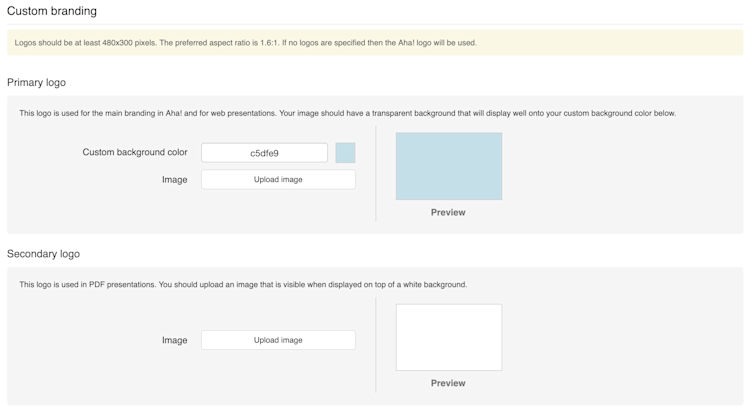
Create a custom dashboard
Dashboards consolidate reports, charts, and roadmaps into a single view. As you choose the right visual reports and roadmaps for your stakeholders, think about how you might use a dashboard to communicate that information. Would they benefit from seeing several different views on one page? You can add almost any view you create in your Aha! account to a single dashboard, organize and annotate the dashboard with text panels, and then share the finished view with your stakeholders.
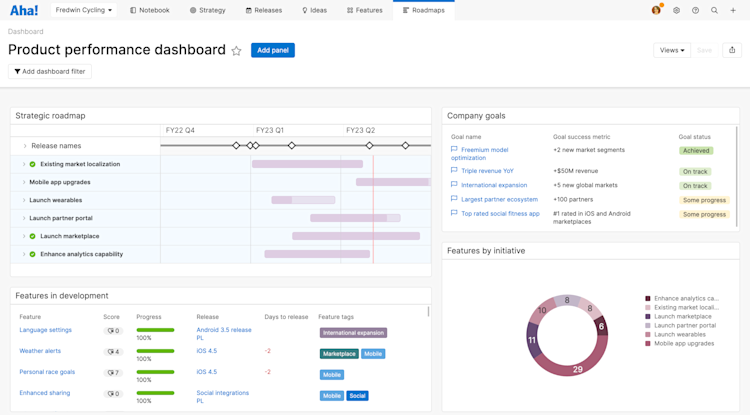
Executive sponsors and strategic programs
When you are reporting your roadmap status to an executive sponsor or a strategic program owner, they want to hear the general "are we good" summary. The level of questions will be similar to the following: "Are we on track to meet our business objectives?," or "Which success metrics are being attacked this quarter?"
Program sponsors are often transferring your roadmap information to higher-level product team members as well. For this reason, their recurring update should be a summary level. They also are looking for how they can help you, with leverage on escalations if needed.
The strategy roadmap is a valuable lead-in report for this level of stakeholder, as they are typically interested in high-level initiatives that link directly to business goals. They want to ensure that everything is on track. The strategy roadmap can stay with those high-level initiatives, or you can choose to include releases, epics and features, then expand the roadmap to show additional levels of detail.
You can visualize cross-team dependencies on the strategy roadmap, to highlight items that an initiative depends on that might not be visible on the roadmap.
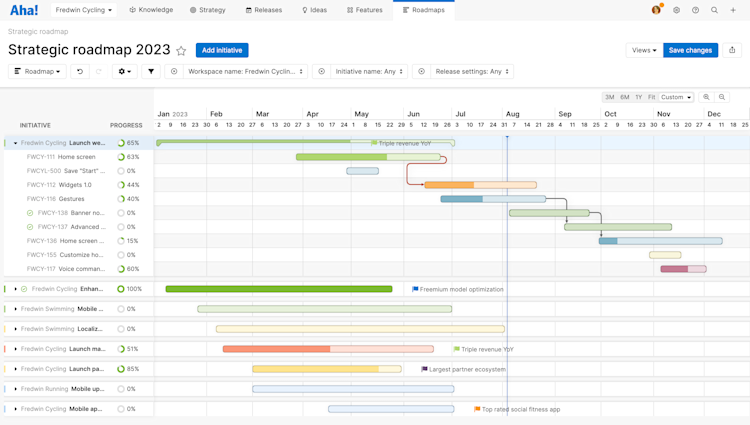
The product value report helps show the impact of your efforts. Rather than rely on the volume of ideas captured or features shipped as a proxy metric for value, use this report to shift the conversation towards value-based product development. The report shows you a summary of the value delivered at every stage of your product development journey. Use it to show the impact of your efforts, inform conversations about the priorities your team is making — and focus on delivering what customers truly care about.
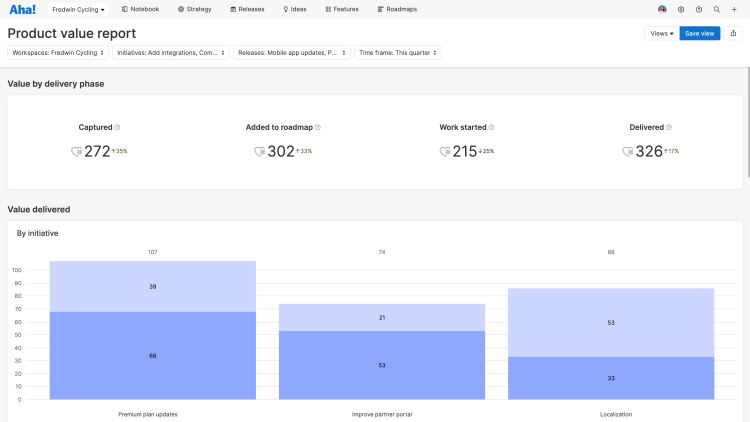
You can also consider the diagram report for this audience if the focus of the discussion is that strategic goals/initiatives have roadmap coverage. Have a potential drill-down view like the features roadmap at the ready for detail backup.
Development teams
Technical teams like developers and engineers need to feel confident that they are building what matters. They want to know that there is passion and buy-in about their daily activities supporting your product, service, or program. The features roadmap is also a great way to introduce these concepts, and how both individual features and the plan roll up to important business objectives.
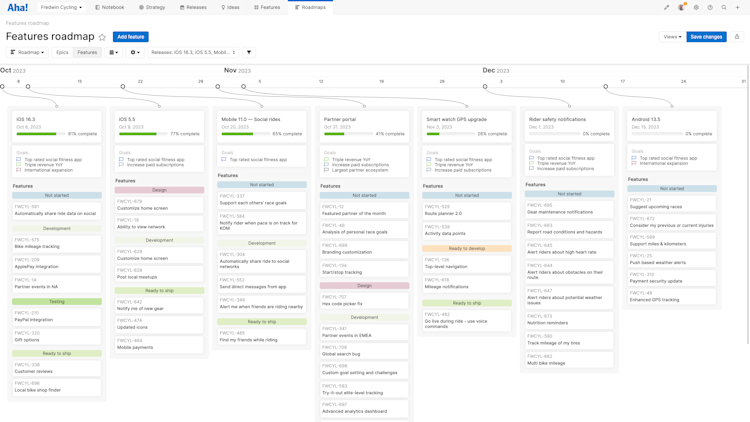
Sharing this even at earlier stages of planning is also a great way to leverage the development team's expertise on slight prioritization changes for features, in case there's a key technical efficiency to be gained with development timing.
As part of the planning process, it's also important to ensure that they have all of the detail required to develop the features. In this case, a custom list report of features and requirements will be a powerful visual view to efficiently confirm that a large effort has the right level of feature definition to execute.
Finally, every development team cares about capacity. Ambitious goals are meaningless unless they are tied to a team with the bandwidth and resources to work towards them. The capacity report breaks down each month into users and the features assigned to them. And through integrations with developer tools, development teams can populate this report with accurate effort estimations.
Project and program management
Managers of programs and projects are often looking for risks across products and releases. For this type of discussion across roadmap owners, the Gantt chart can be used to easily visualize key milestones across workspaces and releases and how they depend upon or affect each other.
You can visualize cross-team dependencies on the Gantt chart, to highlight items that a release or epic depends on that might not be visible on the roadmap.
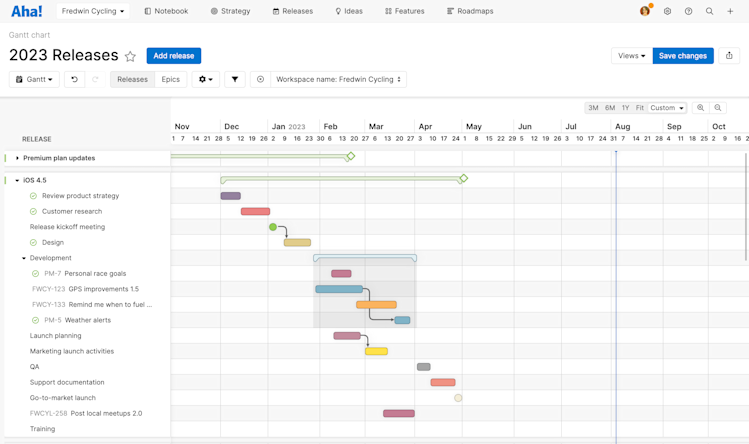
Quickly create dependencies across any two releases in your portfolio, to show what must be completed to keep your upcoming release on track. Then, create custom reports and charts to analyze critical dependencies.
Use the [Record type] record links table in any list, pivot, or chart report (or custom roadmap!). Then, add the Linked [record type] table and select any field (like Status, Assignee, or Due date) on the linked record's layout.
For a focused view of critical dependencies, filter these reports to show only records with Depends on/Dependency of relationships. You can also add information about manual and automatic risk indicators. Then, add your filtered report as a dashboard panel.
View dependencies for multiple objects at once using the dependency report.
For detailed status on features within a roadmap plan, use the features roadmap with feature status enabled under Customize view ⚙️.
Add filters for specific initiatives or goals as needed depending on the program owner's area of responsibility and add progress bars for epics, features, and/or releases to give an exact understanding of how each project or program is developing.
Expand the History tab to track changes to your plan.
Finally, project and program managers often need insight into the team's capacity for a given project. Knowing who has available bandwidth — and who is overburdened with work — helps them manage risk of deadlines slipping and make triage decisions early. The capacity report fits this need perfectly.
Customers
For customers, you want a roadmap that creates excitement, while still sharing only what you're ready to share. Leverage the features roadmap with external dates at the level of precision you are comfortable sharing with that audience, and hide any features from the Aha! Roadmaps presentation that may not be committed yet.
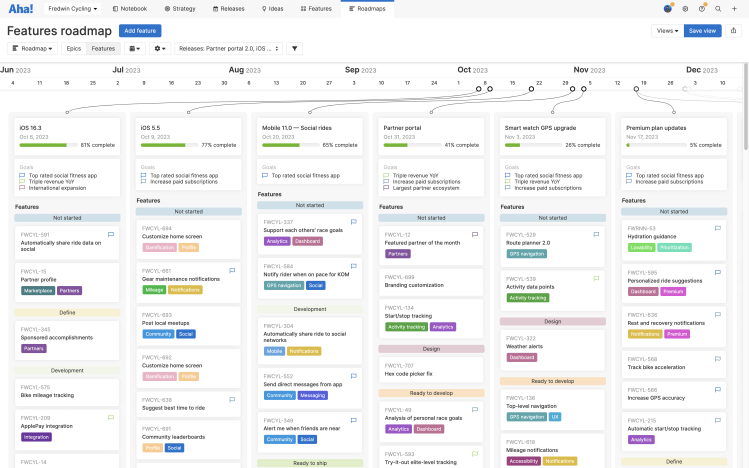
That "special" stakeholder
How stakeholders receive and process your roadmap message can be unique. Leverage custom reports like the custom roadmap to get just that right message format that resonates with your audience.
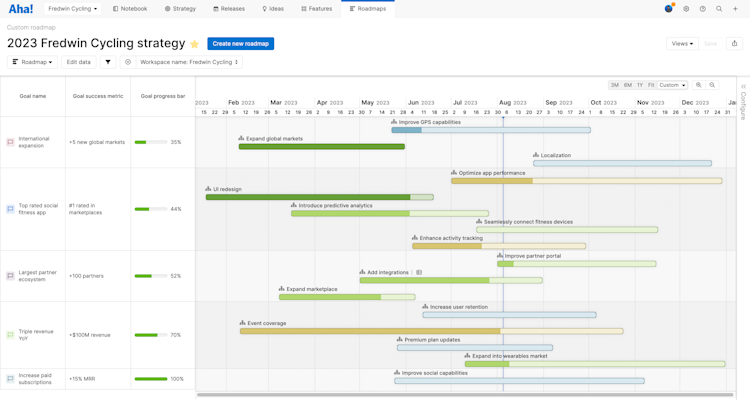
All stakeholders can be unique in their needs regarding communication on your roadmap. By leveraging the work you've already done in your roadmap and saved reports for these stakeholders, you can provide just the updates everyone needs to gain passion, buy-in, and the right-sized information on the plan.
Save your views
To save your current view, click the Save view button in the top right corner of the page. When you save a view, you will have the option to name it, choose who you wish to share your saved view with, and select if others can edit the view. The Views dropdown lets you access any view you have ever saved.
Share your reports and roadmaps
With your reports and roadmaps completed, you can easily share them with your stakeholders by selecting one of the export options under the Share menu on the top-right of the screen.
To fold your reports into a presentation, select Add to presentation. In your presentation you can select the report's update frequency.
To add your reports to a dashboard, select Add to dashboard. Dashboards combine several Aha! Roadmaps views into one page to tell a complete story about your plans and progress.
To invite people outside of your Aha! Roadmaps account to view your reports, select Share as webpage.
To schedule recurring email delivery of your reports and roadmaps, select Schedule email delivery.
To export your list report for further analysis, select Export to Excel or Export to CSV. You can import from CSV to update data later.
For a static version of your reports, export your report to PNG image or PDF document.